
Concept explainers
(a)
To find: The power by using Statistical Power applet.
(a)
Answer to Problem 115E
Solution: The power is 0.885.
Explanation of Solution
To obtain the power by using “Statistical Power applet”, follow the steps below:
Step1: Go to the “Statistical power” on the website. The screenshot is shown below:
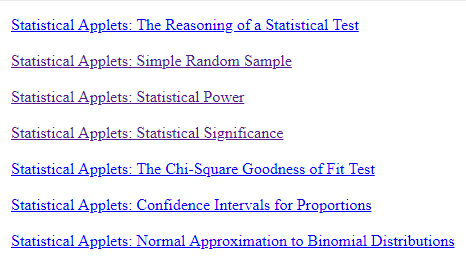
Step2: Specify “
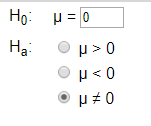
Step3: Specify

Step4: Specify Alpha
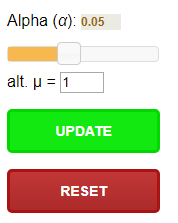
The obtained result is shown below:

The obtained power is 0.885.
To find: The power for different values of
Answer to Problem 115E
Solution: The table providing
| Power | |
| 0.1 | 0.062 |
| 0.2 | 0.097 |
| 0.3 | 0.158 |
| 0.4 | 0.244 |
| 0.5 | 0.353 |
| 0.6 | 0.475 |
| 0.7 | 0.600 |
| 0.8 | 0.716 |
| 0.9 | 0.812 |
Explanation of Solution
Calculation:
To obtain the power by using Statistical Power applet, follow the steps below:
Step1: Go to “Statistical power” on the website. The screenshot is shown below:

Step2: Specify “

Step3: Specify

Step4: Specify Alpha
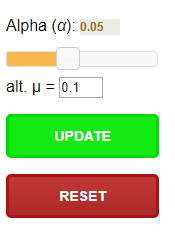
The obtained result is shown below:
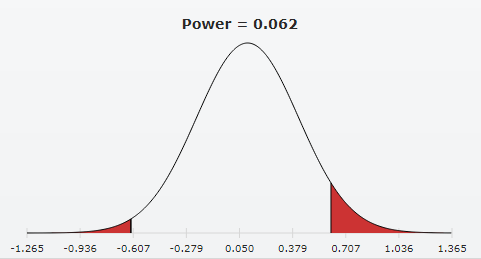
The obtained power is 0.062. Now, repeat this process for the other provided values of
| Power | |
| 0.1 | 0.062 |
| 0.2 | 0.097 |
| 0.3 | 0.158 |
| 0.4 | 0.244 |
| 0.5 | 0.353 |
| 0.6 | 0.475 |
| 0.7 | 0.600 |
| 0.8 | 0.716 |
| 0.9 | 0.812 |
To explain: The obtained power.
Answer to Problem 115E
Solution: The power decreases as the alternative changes from one-sided alternative to the two-sided alternative.
Explanation of Solution
Power of a test is the capability to discard the null hypothesis when it is not true. It can be seen from the obtained table in exercise 6.114 that as the value of
(b)
To find: The power.
(b)
Answer to Problem 115E
Solution: The power is calculated as 0.353.
Explanation of Solution
Calculation:
To obtain the power by using the “ Statistical Power applet”, follow the steps below:
Step1: Go to the “Statistical power” on the website. The screenshot is shown below:

Step2: Specify “

Step3: Specify

Step4: Specify Alpha

The obtained result is shown below:
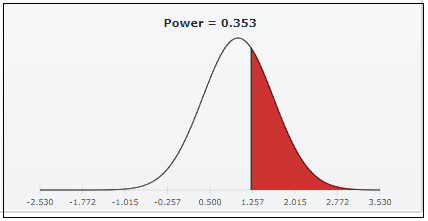
The obtained power is 0.353.
To find: The power for the different values of
Answer to Problem 115E
Solution: The table providing
| Power | |
| 0.1 | 0.053 |
| 0.2 | 0.062 |
| 0.3 | 0.076 |
| 0.4 | 0.097 |
| 0.5 | 0.124 |
| 0.6 | 0.158 |
| 0.7 | 0.198 |
| 0.8 | 0.244 |
| 0.9 | 0.296 |
Explanation of Solution
Calculation:
To obtain the power by using theStatistical Power applet, follow the steps below:
Step1: Go to the “Statistical power” on the website. The screenshot is shown below:

Step2: Specify “
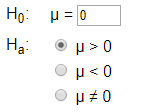
Step3: Specify

Step4: Specify Alpha

The obtained result is shown below:
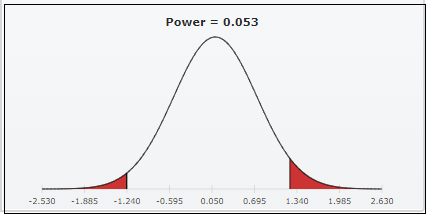
The obtained power is 0.053. Now, repeat this process for the other provided values of
| Power | |
| 0.1 | 0.053 |
| 0.2 | 0.062 |
| 0.3 | 0.076 |
| 0.4 | 0.097 |
| 0.5 | 0.124 |
| 0.6 | 0.158 |
| 0.7 | 0.198 |
| 0.8 | 0.244 |
| 0.9 | 0.296 |
To explain: The obtained power.
Answer to Problem 115E
Solution: The power decreases as
Explanation of Solution
Power of a test is the capability to discard the null hypothesis when it is not true. It can be seen from the obtained table in the exercise 6.114 that as the value of
(c)
To find: The power.
(c)
Answer to Problem 115E
Solution: The power is calculated as 0.994.
Explanation of Solution
Calculation:
To obtain the power by using the “ Statistical Power applet”, follow the steps below:
Step1: Go to the “Statistical power” on the website. The screenshot is shown below:

Step2: Specify “

Step3: Specify

Step4: Specify Alpha

The obtained result is shown below:
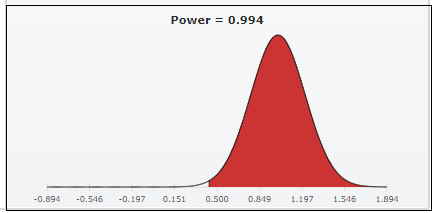
The obtained power is 0.994.
To find: The power for the different values of
Answer to Problem 115E
Solution: The table providing
| Power | |
| 0.1 | 0.073 |
| 0.2 | 0.145 |
| 0.3 | 0.269 |
| 0.4 | 0.432 |
| 0.5 | 0.609 |
| 0.6 | 0.765 |
| 0.7 | 0.879 |
| 0.8 | 0.947 |
| 0.9 | 0.981 |
Explanation of Solution
Calculation:
To obtain the power by using theStatistical Power applet, follow the steps below:
Step1: Go to the “Statistical power” on the website. The screenshot is shown below:

Step2: Specify “

Step3: Specify

Step4: Specify Alpha

The obtained result is shown below:
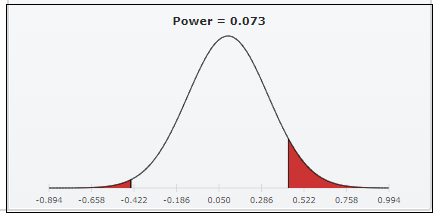
The obtained power is 0.073. Now, repeat this process for the other provided values of
| Power | |
| 0.1 | 0.073 |
| 0.2 | 0.145 |
| 0.3 | 0.269 |
| 0.4 | 0.432 |
| 0.5 | 0.609 |
| 0.6 | 0.765 |
| 0.7 | 0.879 |
| 0.8 | 0.947 |
| 0.9 | 0.981 |
To explain: The obtained power.
Answer to Problem 115E
Solution: The power increases as the ‘n’ changes 10 to 20.
Explanation of Solution
Power of a test is the capability to discard the null hypothesis when it is not true. It can be seen from the obtained table in the exercise 6.114 that as the value of
Want to see more full solutions like this?
Chapter 6 Solutions
EBK INTRODUCTION TO THE PRACTICE OF STA
- Algebra & Trigonometry with Analytic GeometryAlgebraISBN:9781133382119Author:SwokowskiPublisher:Cengage
 Algebra: Structure And Method, Book 1AlgebraISBN:9780395977224Author:Richard G. Brown, Mary P. Dolciani, Robert H. Sorgenfrey, William L. ColePublisher:McDougal Littell
Algebra: Structure And Method, Book 1AlgebraISBN:9780395977224Author:Richard G. Brown, Mary P. Dolciani, Robert H. Sorgenfrey, William L. ColePublisher:McDougal Littell

 Trigonometry (MindTap Course List)TrigonometryISBN:9781337278461Author:Ron LarsonPublisher:Cengage Learning
Trigonometry (MindTap Course List)TrigonometryISBN:9781337278461Author:Ron LarsonPublisher:Cengage Learning




